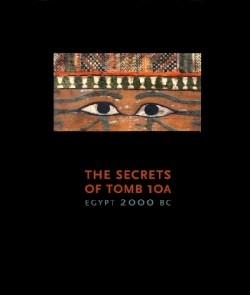
The Secrets of Tomb 10A
Napoleon was victorious in at least two things: the Battle of the Pyramids and unearthing widespread interest in ancient Egypt. Our fascination continues with Egypt’s marvels, mummies, and mysteries.
The Secrets of Tomb 10A* is a catalog of the artistic and historic treasures discovered in Djehutynakht’s tomb (10A) of the Middle Kingdom of ancient Egypt, which complements an exhibition at the Museum of Fine Arts in Boston (Oct. 18, 2009—May 16, 2010). Curators at the museum contribute essays; Freed is exhibition curator and chair of the museum’s Art of the Ancient World Department.
Study of ancient Egypt is generally divided into three major eras: Old Kingdom (2649—2100 BC); Middle Kingdom (2040—1640 BC), considered to be the “classical age of cultural achievement,” writes Curatorial Research Associate Picardo; and New Kingdom (1550—1070 BC). In his essay, “Middle Kingdom History, Politics, and Social Organization,” Picardo proposes that the Middle Kingdom, despite its cultural achievements, receives less acclaim than the other two periods because it lacks the notoriety that accompanies “iconic” monuments and their sensational discoveries, such as the pyramids or King Tutankhamen’s tomb.
In 1915, a team of archaeologists led by George Andrew Reisner, professor of Egyptology at Harvard, in conjunction with the museum, traveled to Deir el-Bersha, a necropolis in central Egypt near the ancient city of Hermopolis. After digging down thirty feet to tomb “10, pit A,” the excavators found the tomb’s entrance. Inside were damaged coffins, peeled mummies, and other objects scattered by plunderers, who had taken gold and semi-precious stones. Objects included staves, headrests, stone vessels, canopic jars, and wooden models, which “were masterworks of Egyptian art,” writes Doxey, curator of Ancient Egyptian, Nubian, and Near Eastern Art. It has taken nearly a hundred years to prepare the current museum exhibition.
Doxey’s essay, “Funerary Beliefs and Practices in the Middle Kingdom,” provides notes of interest, such as the reason for religious inscriptions known as Pyramid Texts in burial chambers and the mummy of Wah, wrapped in 375 square yards of linen.
Berman, senior curator of Ancient Egyptian, Nubian, and Near Eastern Art, describes the construction and art of Djehutynakht’s oblong box, known as the Bersha coffin, in “The Coffins and Canopic Chests of Tomb 10A.” He details the Coffin Texts’ delicately carved and painted hieroglyphs, and clarity of coloration. Images were of funeral rites for passage to the next world; there are spells with lines such as: “I am Horus. I have come to you.” Of note are incised and painted “sacred eyes” on the front of the coffin through which Djehutynakht could see the way to the world of the dead. He was a provincial governor or regional lord, known as a nomarch; also described is his wife’s coffin.
Wooden models of people, animals, and boats were originally placed on top and around the coffins and “intended to provide symbolically for the owners’ kas (life force) and therefore represented “an ideal or anticipated living standard for the afterlife,” write Freed and Doxey in “The Djehutynakhts’ Models.”
The governor’s tomb contained more than 100 models including bakers, brewers, and brick makers. There were fifty-eight boats depicting funerary barks, kitchen barges, and military transports. The finest model is the “Bersha Procession,” four figures carrying ritual offerings. The finely carved and delicately painted figures, standing fifteen inches high, feature heads, torsos, and legs carved as one piece with arms and elbows pegged in place. A priest with pink skin and yellow hair leads the procession carrying a censor and vase followed by three svelte women; two carry decorated boxes on their heads and painted ducks in their hands, “each small bird a work of art in itself”; the third holds a stool painted to look like it was upholstered in leopard-skin. These, incredibly, were made 4,000 years ago.
The book would benefit from fewer redundancies, but the explanations and photography are precise and pristine. Art and history cognoscenti will enjoy this book.
“Wonderful things,” was Egyptologist Howard Carter’s reply after being asked what he saw upon discovering King Tutankhamun’s tomb; the phrase is apropos of what The Secrets of Tomb 10A* reveals.
Disclosure: This article is not an endorsement, but a review. The publisher of this book provided free copies of the book to have their book reviewed by a professional reviewer. No fee was paid by the publisher for this review. Foreword Reviews only recommends books that we love. Foreword Magazine, Inc. is disclosing this in accordance with the Federal Trade Commission’s 16 CFR, Part 255.
